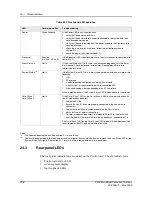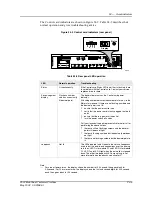
25 — Alarms
25-2
2902 MainStreet Technical Practices
90-2906-01 May
2002
25.1
Alarms and alarm queues
The 2902 MainStreet system continuously monitors itself for abnormal conditions or
significant events. When an abnormal condition is detected or a significant event
occurs, an alarm is recorded in one of the three alarm queues:
•
Major/Prompt (event alarms)
•
Minor/Deferred
•
Diagnostic/In Station
Each alarm queue can hold up to 64 alarms. For some alarms, you can configure in
which queue the alarm is recorded.
When an alarm is recorded in the Major/Prompt queue, the Event Status LED on the
front panel lights. The LED remains lit until the alarm is acknowledged. See
section 24.2 for more information about the Event Status LED.
The 2902 MainStreet system has an external alarm function that allows you to
monitor or activate an external device (see section 25.7).
Alarm codes and clearing codes
Each alarm in an alarm queue includes information such as date and time of the
alarm, as well as an alarm code. The alarm code is a brief description of the nature
of the alarm.
Some alarms codes have corresponding clearing codes, which inform you that the
alarm condition no longer exists. Clearing codes are added to the appropriate alarm
queue. Clearing codes have names that are similar to their corresponding alarm codes
but include terms such as cleared, removed, restored and normal. For example, the
alarm code “AIS - All Ones” has the clearing code “AIS - All Ones Cleared”, while
the alarm code “Busy Out Applied” has the clearing code “Busy Out Removed”.
Table 25-1 lists and describes the alarm codes. Alarm codes marked with an
asterisk (*) have a corresponding clearing code. Some alarm codes have subcodes
and parameters that are used by Alcatel field service representatives. Subcodes and
parameters that are useful to maintenance functions are given in the table.
Note 1 —
Maintenance on the module in physical position M2 is
accessed through NMTI module position 9.
Note 2 —
Maintenance information on module position 9 is not
available when position 9 is disabled by position 1 (during a
super-rate connection). See section 19.11 in
Configuration
for details.
Summary of Contents for MainStreet 2902
Page 1: ...2902 MainStreet Network Termination Unit Release 1 0 H T E C H N I C A L P R A C T I C E S ...
Page 40: ...3 Mounting the unit 3 8 2902 MainStreet Technical Practices 90 2906 01 May 2002 ...
Page 50: ...4 Ground and power connections 4 10 2902 MainStreet Technical Practices 90 2906 01 May 2002 ...
Page 68: ...6 Connecting to the network 6 4 2902 MainStreet Technical Practices 90 2906 01 May 2002 ...
Page 90: ...7 Connecting to data devices 7 22 2902 MainStreet Technical Practices 90 2906 01 May 2002 ...
Page 108: ...10 Node management 10 10 2902 MainStreet Technical Practices 90 2906 01 May 2002 ...
Page 150: ...14 CPSS 14 6 2902 MainStreet Technical Practices 90 2906 01 May 2002 ...
Page 218: ...20 Codirectional DCM 20 6 2902 MainStreet Technical Practices 90 2906 01 May 2002 ...
Page 234: ...22 HCM rate adaption 22 10 2902 MainStreet Technical Practices 90 2906 01 May 2002 ...
Page 246: ...23 Cross connecting circuits 23 12 2902 MainStreet Technical Practices 90 2906 01 May 2002 ...
Page 254: ...24 Visual indicators 24 8 2902 MainStreet Technical Practices 90 2906 01 May 2002 ...
Page 266: ...25 Alarms 25 12 2902 MainStreet Technical Practices 90 2906 01 May 2002 ...
Page 278: ...26 System diagnostics 26 12 2902 MainStreet Technical Practices 90 2906 01 May 2002 ...
Page 298: ...27 Loopbacks 27 20 2902 MainStreet Technical Practices 90 2906 01 May 2002 ...
Page 332: ...Glossary GL 8 2902 MainStreet Technical Practices 90 2906 01 May 2002 ...
Page 343: ......
Page 344: ... 2002 Alcatel All rights reserved 90 2906 01 95 1820 01 00 C ...
















































